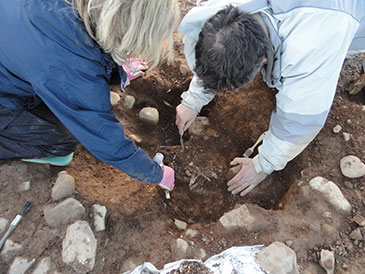The monument was previously classified as a standing stone, probably of Early Bronze Age date (c 2,200 BC), and received little attention until, in 2009, an archaeological team, led by Dr George Nash of the University of Bristol, Carol James (Welsh Rock Art Organisation), Adam Stanford (Aerial Cam) and Thomas Wellicome (University of Southampton), undertook a geophysical survey.
The results led them to believe that the stone, which is decorated with over 75 cupmarks, is a capstone once supported by a series of upright stones to form a Neolithic burial chamber, probably a Portal Dolmen, one of Western Britain’s earliest burial monument types.
The team continued excavating the site for another two seasons and, in 2012, cremated bone weighing around 1.9 kg was discovered in one of the trenches that stood close to the stone. The cremation, located within a stony deposit, was accompanied by later prehistoric pottery, probably grooved ware. The survival of the cremation and the pottery is particularly remarkable as the surrounding soil is extremely acidic and the area was ploughed during historical times.
The cremation and the surrounding deposits were carefully excavated and lifted by Welsh archaeologist Catarina Rees and sent to osteoarchaeologist Dr Jacqueline McKinley of Wessex Archaeology for dating and analysis. The burial was also radiocarbon dated to between 2,200 and 1,900 BC.
Dr Nash said: "The cremation burial, one of only a handful within this part of Western Britain to be dated using modern chronometric dating techniques, clearly shows that Trefael was more than just a standing stone. Careful archaeological excavation over three years has shown that the site has been utilised over at least a 5,000 year period.
"The cremation burial, along with an excavated burial chamber belonging to a Bronze Age cairn, are among a number of significant discoveries from this remarkable site and clearly show a relationship between Neolithic and Early Bronze Age mortuary practices."
Phil Bennett, Culture and Heritage Manager of the Pembrokeshire Coast National Park where the site is located, said: "It's so rewarding to see opportunities to better understand the rich and varied archaeological heritage of the National Park. In particular we welcome the opportunity to enable visitors, residents and young people to better enjoy and learn about their National Park.
"The more we learn about the ancient landscapes of the National Park, the more likely it is that people will respect and want to protect them. In supporting work by Dr Nash and others, the National Park Authority believes that such work will highlight and enhance the importance of the Park's prehistoric past."
